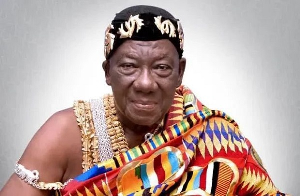LIVE: Final Funeral Rites for Mamponghene Daasebre Osei Bonsu II Begin in Grand Traditional Ceremony

The final funeral rites for the late Mamponghene, Daasebre Osei Bonsu II, the esteemed occupant of the revered Silver Stool of the Asante Kingdom, began on Saturday, June 7, 2025, with a profound display of tradition, royalty, and solemn remembrance. The three-day event, known locally as ‘Dote Yie’, marks the final journey of a revered traditional ruler whose legacy stretched across decades of leadership, diplomacy, and public service.
The funeral will run from Saturday through Monday, June 9, 2025, with the peak of ceremonial homage and attendance expected on Sunday, June 8, when a host of political dignitaries and traditional leaders are scheduled to arrive to pay their final respects.
A Nation Mourns a Revered Chief
Born on December 31, 1939, Daasebre Osei Bonsu II passed away at the age of 86, after serving as Mamponghene for an illustrious 26 years. As the second most powerful ruler in Asanteman, his passing leaves not only a deep void in the traditional hierarchy of the Ashanti Kingdom but also in the broader landscape of Ghanaian leadership and governance.
Before ascending to the Silver Stool, Daasebre Osei Bonsu was known as Saint Oswald Gyimah-Kessie, a man of great intellect and professional distinction. A lawyer and economist by training, he served as Registrar of the Kwame Nkrumah University of Science and Technology (KNUST) and brought his expertise in academia and administration to his traditional rule. His dual identity as a scholar and a traditional authority figure made him both respected and beloved across different spheres of Ghanaian society.
Day One: Traditional Rulers and Royal Homage
The first day of the funeral rites attracted an impressive gathering of traditional leaders from across the Ashanti region and beyond. The courtyard of the Mampong palace was filled with dignitaries in regal kente, clad in traditional black and red mourning cloths, a striking symbol of both sorrow and respect.
Notable among those present were:
-
Kwahumanhene, Daasebre Akuamoah Boateng III
-
Mamponghene Abrempong
-
Effiduasehene, Nana Adu Ameyaw II
-
Ejurahene, Barima Osei Hwedie II
These figures, each holding their own important role within the Asanteman traditional structure, came to pay homage to a chief who, for over two decades, had played a stabilizing and wise role in the kingdom’s governance and judicial functions.
Adding a continental flavor to the event was the royal delegation from Eswatini (Southern Africa), who attended as representatives of King Mswati III. Their presence highlighted Daasebre Osei Bonsu’s influence beyond Ghanaian borders and his recognized role in African traditional leadership networks.
A Touching Family Farewell
Among the many poignant moments was the emotional tribute paid by the wife and daughter of the late chief, who stood quietly beside the Silver Stool in farewell. Their presence added a deeply personal dimension to the day’s rituals, reminding all in attendance that beyond the stature and ceremonial grandeur was a family grieving a father, husband, and mentor.
Witnesses described the scene as one of solemn beauty, as traditional dirges were sung and libations poured in honor of a life well-lived and a legacy well-earned.
Day Two: Political Figures and National Tributes
The second day of the Dote Yie, scheduled for Sunday, June 8, is anticipated to draw national attention, with the arrival of high-ranking political figures, including former President Dr. Mahamudu Bawumia, among others. The presence of such dignitaries is a testament to the high esteem in which Daasebre Osei Bonsu II was held across both traditional and state institutions.
Sunday’s ceremonies will likely include:
-
National eulogies recognizing his role in maintaining peace and guiding customary law
-
Official state and regional government tributes
-
Processions involving the various Asafo (warrior groups) and palace courtiers
-
Choral and traditional musical performances in celebration of his life
The inclusion of national political figures serves as a bridge between Ghana’s traditional governance systems and its modern state apparatus—both of which Daasebre Osei Bonsu straddled with rare dignity.
Legacy of Leadership and Diplomacy
Daasebre Osei Bonsu II’s reign as Mamponghene was marked by a unique blend of cultural guardianship and forward-thinking governance. He played an essential role in the Asante Kingdom’s council of chiefs and acted frequently as a mediator during disputes both within and outside the traditional structures.
His background as a lawyer and administrator brought a measured, analytical approach to chieftaincy. Colleagues often praised his deep knowledge of customary law, coupled with a vision for peaceful coexistence between modern democratic institutions and indigenous rule.
As a traditional diplomat, he represented the Ashanti Kingdom in numerous cultural exchanges, and his work was instrumental in preserving customs while embracing new forms of leadership relevant to contemporary Ghana.
Looking Ahead
As the final rites conclude on Monday, June 9, a successor will eventually be chosen to occupy the Silver Stool, but the shoes left behind by Daasebre Osei Bonsu II will be difficult to fill. His tenure will be remembered as one of calm leadership, cultural dignity, and generational influence.
In the coming days, thousands are expected to travel to Mampong to witness the closing rituals, offer condolences, and participate in a cultural moment that transcends grief—celebrating instead the enduring power of tradition and the life of a chief who embodied its very essence.
In a country where tradition and modernity often exist in parallel, the funeral rites of Daasebre Osei Bonsu II serve as a poignant reminder of the roles traditional leaders continue to play in shaping the soul of the nation.
Watch a livestream of the ‘Dote Yie’ below:





